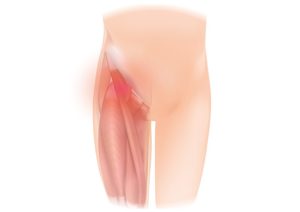by Dr. Benjamin Domb, M.D., Founder, Medical Director & Orthopedic Surgeon at The American Hip Institute & Orthopedic Specialists, special to SportsMD.com

Most individuals associate hip pain with the elderly population; however, research has shown it affects a wide array of people, from the young active adolescent, the casual adult “weekend-warrior” to pro-athletes. Since many individuals believe they are too young to experience hip joint degeneration, they delay seeking treatment, further progressing hip damage and prolonging their suffering. In pain, they are quick to accept other diagnoses, which are often incorrect, leading to increased discomfort and frustration.
In fact, nearly two thirds of athletes undergoing hip arthroscopy were originally misdiagnosed, further delaying their pain relief by, on average, more than half a year. In 17% of these patients, physicians had recommended surgical intervention at sites outside of the hip joint, which could have resulted in an unnecessary surgery.
Why is hip pain so easily misdiagnosed?
 Well, it is often difficult to pinpoint pain in reference to a structure, especially one as large as the hip. When we get a high ankle sprain, we can point out exactly where it hurts. Similarly, if we fall on our elbow, a bruise will reveal the source of discomfort. Instead, the hip joint is deep and surrounded by a variety of structures and tissues; making it more difficult for a physician to deduce the origin of the pain when a patient cups her hip with her hand and states “it hurts throughout this area”. The pain is less localized and more general, making it difficult to differentiate a pulled groin from torn cartilage.
Well, it is often difficult to pinpoint pain in reference to a structure, especially one as large as the hip. When we get a high ankle sprain, we can point out exactly where it hurts. Similarly, if we fall on our elbow, a bruise will reveal the source of discomfort. Instead, the hip joint is deep and surrounded by a variety of structures and tissues; making it more difficult for a physician to deduce the origin of the pain when a patient cups her hip with her hand and states “it hurts throughout this area”. The pain is less localized and more general, making it difficult to differentiate a pulled groin from torn cartilage.
In order to avoid running in circles of misdiagnosis, it is best to consult a hip specialist about the hip pain. Diagnosing hip problems can be difficult and nuanced, so it is vital that patients contact a physician who is trained in recognizing and revealing subtle hip abnormalities on physical exam and through diagnostic imaging to deduce the cause of the pain.
Pathway to treatment

Once an orthopedic surgeon has correctly diagnosed a hip ailment, it is important to understand that surgery is not the only option. Sometimes, hip pain can be relieved with conservative treatment. First, a physician may suggest a course of physical therapy to strengthen the surrounding muscles in addition to NSAID use and activity modification. If this does not provide relief, biologic injections may be the next step. Both platelet-rich-plasma (PRP) and stem cells can be injected into the affected area to stimulate repair and healing of the injured tissue.
When conservative measures fail to provide pain relief, arthroscopic hip surgery may be the best option to relieve the pain. Arthroscopic intervention can correct a torn labrum (the cartilage ring that seals the hip joint), a misshapen femoral head or acetabular rim, cartilage damage, stiffness, instability, and more. Electing to fix small defects early can prevent further degeneration, preserving a patient’s native joint and preventing the need for a total hip replacement in the future.
Get a plan tailored to your pain needs

If you are experiencing symptoms such as hip pain, clicking, popping, and stiffness, or if your current treatment plan for a different diagnosis has not improved your condition, it is in your best interest to consult a hip specialist. This decision will allow you to be thoroughly evaluated and treated with a personalized plan tailored to your needs that aims to primarily address your pain. Fortunately, hip pain can be treated both conservatively and surgically, so your treatment plan can be tailored to your goals, lifestyle, and wishes. Regardless of the chosen modality, the end goal is to help you return to your daily activities with restored function and comfort.
Dr. Benjamin Domb, M.D., Founder, Medical Director & Orthopedic Surgeon at American Hip Institute & Orthopedic Specialists, is on a mission to educate and treat hip pain with the most advanced, comprehensive and non-invasive medical solutions. Based in Chicago, AHI offers a range of cutting-edge techniques in hip arthroscopy and robotic hip replacements, including Hip Resurfacing and Stem Cells and Regenerative Medicine. For more information or to schedule a consultation with Dr. Domb at American Hip Institute & Orthopedic Specialists, visit: www.americanhipinstitute.com.
Cover Image: Unsplash/Jonathan Chng

